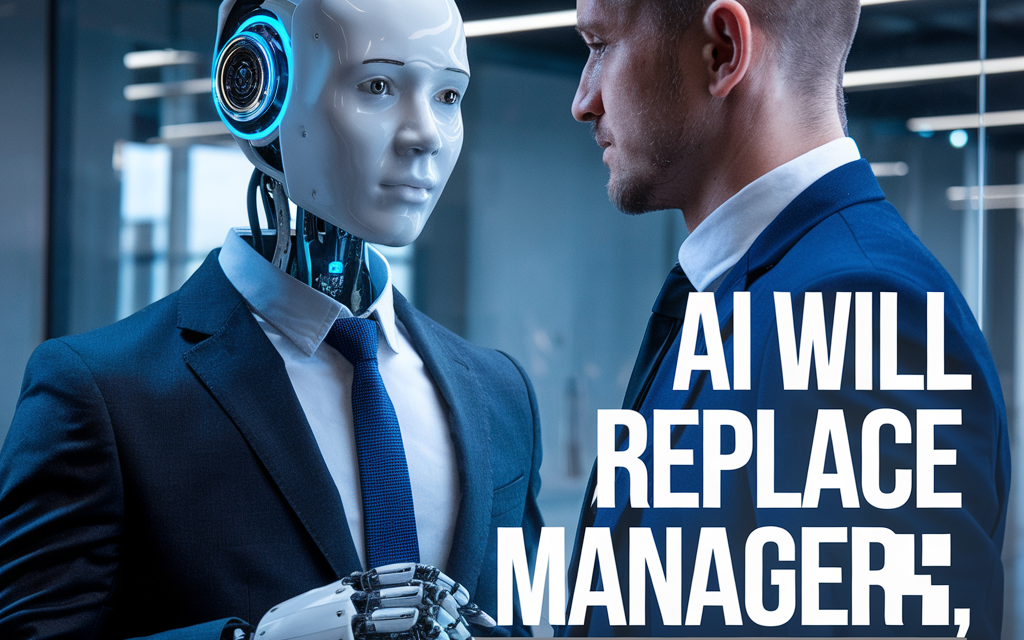
AI Will Replace Managers, Not Sales Reps

For years, the looming narrative has been that AI will replace human workers, and sales reps often find themselves at the center of this fear. But the truth is far more nuanced—and significantly more provocative. What if AI replaces managers long before it replaces sales reps? Why would I suggest such an audacious thing? Because the tasks AI excels at—data analysis, operational oversight, and playbook execution—are foundational to managerial roles, not human-to-human sales interactions.
The rise of AI in sales isn’t a threat to reps; it’s a call to arms. Salespeople of the future won’t need to be jacks-of-all-trades. Instead, their role will evolve, requiring a narrower set of deeply human skills that will become more essential than ever. The role of the sales manager, meanwhile, faces a fundamental reshaping—or obsolescence.
This shift raises critical questions. How will leadership evolve in a world where AI handles many of the traditional managerial tasks? And what specific skills will sales reps need to thrive in a transformed sales landscape? Let’s explore these questions and unpack how AI is reshaping the sales organization from the ground up.
The Managerial Role: Ripe for Automation
Managerial tasks are, by design, structured and repetitive. AI thrives in this environment, handling tasks with precision and efficiency. Here’s why AI is a natural replacement for many traditional managerial functions:
1. Data-Driven Insights on Autopilot
Managers spend hours dissecting performance metrics—call logs, pipeline health, conversion rates—and often rely on intuition to draw conclusions. AI tools like Gong.io, Clari, and Salesforce Einstein render this process obsolete. They analyze vast amounts of data in real time, delivering insights on team performance, deal health, and customer behavior.
Imagine a sales manager reviewing a quarterly report to identify lagging performers. An AI system not only identifies the reps struggling to close deals but also pinpoints the specific behaviors causing underperformance, such as poor follow-up cadence or lack of engagement during discovery calls. The result? Instant, actionable feedback without human intervention.
2. Real-Time Coaching and Feedback
AI coaching tools provide feedback at scale, something human managers can’t replicate consistently. Platforms like Sybill and Attention.tech analyze sales conversations in real time, flagging moments where reps lose buyer interest, miss key objections, or fail to align with the buyer’s priorities. The coaching is instantaneous, precise, and scalable.
A rep misses an opportunity to upsell during a demo call. AI steps in with an in-call nudge: “Highlight the enterprise-tier features,” or “Ask about future scaling needs.” This kind of proactive feedback eliminates the lag time between a call and a post-mortem review.
3. Playbook Execution Without Oversight
Sales managers often act as enforcers, ensuring reps follow established processes. AI systems make this redundant. Modern tools don’t just enforce playbooks; they guide reps dynamically in real time.
A rep navigating a discovery call might be prompted by AI to ask specific questions based on the buyer’s industry and job title, surfacing relevant case studies or ROI calculators on the fly. This dynamic support ensures compliance with playbooks without constant managerial oversight.
Sales Reps of the Future: Narrower Skills, Greater Impact
While AI might handle the routine tasks of the sales process, it cannot replicate the deeply human elements of selling. Sales reps of the future will focus on a narrower, more impactful set of skills that AI can’t replicate. Ironically, this will make these skills more critical than ever.
1. The Rise of AI Avatars in Early Sales Stages
AI-powered avatars, like those offered by platforms such as 1mind.com, are already capable of handling the initial stages of the sales process. These tools can qualify leads, schedule meetings, and provide advanced product information with decks and demos with remarkable accuracy and efficiency.
This raises an important shift: Reps will no longer need to master every stage of the sales cycle. Instead, they will specialize in later-stage conversations where human connection and creativity are paramount.
Imagine a world where a prospect interacts with an AI avatar to experience a personalized demo, had all their product questions answered, and gathered initial product insights of how it would work for them and their team. By the time the conversation reaches a human rep, the buyer is primed and informed, ready for a strategic discussion that requires nuance and persuasion—skills the rep specializes in.
2. Emotional Intelligence Becomes a Superpower
As AI handles the transactional and data-driven aspects of sales, the value of emotional intelligence (EQ) skyrockets. Reps who can build rapport, read body language, understand how to read a room, and adapt to a buyer’s emotional state will dominate.
For example, during a complex negotiation, AI can surface relevant pricing data or competitive analysis, but it takes a human to detect hesitation in a buyer’s voice or shift the tone of the conversation to ease concerns. (Until AI does that too at least 😉
3. Storytelling and Vision Crafting
Buyers crave compelling narratives that connect the dots between a product and their business challenges. AI can assist by providing data-driven proof points, but only humans can weave those into a relatable, engaging story.
Another example, a SaaS rep might use AI to pull metrics showing how similar companies saved 30% on IT costs. But it’s the rep’s story about how one specific customer leveraged the product to overcome a critical bottleneck that seals the deal.
4. Navigating Ambiguity and Complex Buyer Needs
AI is a pattern-recognition powerhouse, but it struggles with ambiguity. Reps who can ask probing questions and uncover hidden needs that don’t fit neatly into a data model will thrive.
Final example: a buyer’s pain point might not be explicitly tied to budget or functionality but to an internal political challenge. A skilled rep identifies this by reading between the lines, adjusting their approach to address the human factors AI would miss.
AI Empowers, Not Threatens, Sales Reps
The sales reps of the future will not be replaced but empowered by AI. Reps who embrace AI tools to handle routine tasks and augment their abilities will see their productivity—and their value to their organizations—skyrocket.
Leadership Reimagined: Coaches and Visionaries
If AI is set to possibly absorb many a traditional managerial tasks, the role of leadership must evolve. Managers will no longer be tasked with monitoring performance metrics or enforcing playbooks. Instead, their value will lie in their ability to inspire, coach, and guide their teams through ambiguity.
1. From Commanders to Coaches
AI takes care of the “what”—what’s working, what’s not, and what needs to happen next. Leaders of the future will focus on the “how”—how to unlock a team’s potential, how to foster collaboration, and how to navigate challenges with creativity and resilience.
Imagine instead of reviewing pipeline reports, a manager can dive deeper into account strategy with a sales rep or brainstorming ways to overcome a specific buyer objection.
2. Culture Builders
AI can optimize operations, but it can’t create a culture of trust, collaboration, and innovation. Managers must become stewards of culture, ensuring their teams feel connected and valued in an increasingly automated world.
With less stress of admin tasks, a leader might have more time to host regular “open mic” sessions where reps share success stories or challenges, fostering a sense of shared purpose.
3. Strategic Visionaries
While AI handles the minutiae, leaders must focus on aligning their teams with the company’s long-term vision. This includes identifying emerging market trends, evaluating new technologies, and crafting strategies that keep their organizations competitive.
Let’s get a little meta here; what if a manager leads a workshop on how AI trends are reshaping buyer behavior, equipping their team with fresh insights and approaches.
The rise of AI doesn’t spell the end of sales reps or managers—it marks a transformation. Sales reps will shed the burden of routine tasks and focus on honing the human skills AI cannot replicate. Meanwhile, managers will evolve into coaches, culture builders, and visionaries, guiding their teams through a rapidly changing landscape.
The Future of Leadership in an AI-Powered World
With AI poised to take over the routine, tactical, and operational aspects of management, leaders must navigate a new paradigm. Those who resist change risk irrelevance, but those who adapt will thrive as they empower their teams to excel in a world where human ingenuity and AI augmentation go hand in hand.
Let’s focus on actionable strategies for future-proofing leadership, the risks of resistance, and real-world examples of companies leveraging AI to redefine sales and management.
The Risks of Resisting Change
Leaders who cling to outdated practices are jeopardizing not only their roles but also the performance and morale of their teams. Here’s why resistance to AI adoption is particularly damaging:
1. Missed Opportunities for Growth
AI enables teams to scale their efforts without scaling their headcount. Leaders who fail to adopt AI tools like Momentum.io (for deal acceleration) or ProofAnalytics.ai (for revenue attribution) risk leaving untapped opportunities on the table.
2. Burnout from Low-Value Tasks
Without AI, managers are stuck in the weeds—analyzing data, creating reports, and enforcing processes. These repetitive tasks detract from higher-value activities like coaching and strategic planning.
3. Failure to Inspire and Retain Talent
In a world where AI enables efficiency, top performers will gravitate toward leaders who inspire, challenge, and empower them—not those stuck micromanaging or resistant to change.
Redefining Leadership: Skills for the AI Era
AI will not replace the need for leaders—it will amplify the importance of leadership. To remain relevant, managers must adopt a new mindset, focusing on skills that go beyond traditional management.
1. Adopt AI Technology and Lead by Example
Leaders cannot afford to delegate AI adoption to their teams without personal investment. By using tools like TheySaid.ai (for customer feedback analysis), managers demonstrate their commitment to leveraging AI for better decision-making.
Practical Tip: Use AI to analyze your own team’s performance data. Share insights during team meetings, highlighting how AI improves transparency and empowers better collaboration. For pete’s sake at least use ChatGPT or other accessible tech to have another AI mind on the task at hand.
2. Inspire Hearts and Minds
AI handles processes, but leaders must inspire their people. This involves clear communication, empathy, and creating a shared sense of purpose.
Example: A manager at a global sales organization uses AI tools to automate mundane tasks, freeing up time to engage their team in meaningful ways—such as workshops on storytelling or buyer empathy. They regularly highlight the team’s wins and show how AI played a role in achieving success.
3. Develop the Next Tier of Leaders
Leaders MUST be leading the way on the needed cultural shift with . AI adoption. Leaders MUST invest in developing the next generation of managers who will use AI daily. This includes teaching them how to interpret AI-generated insights, thinking critically and creatively, navigate ambiguity, and lead with strategic vision.
Practical Tip: Pair junior leaders with experienced managers for mentorship while integrating AI tools into leadership training programs.
4. Coach Through Change
AI adoption can be unsettling for teams. Effective leaders coach their teams through the transition, addressing fears and ensuring that AI is seen as an enabler, not a threat.
Example: At a retail tech company, a director uses HachlyAI.com to handle a lot of tasks of team members that was manual with website visitors, now their team is able to focus on the warmest leads or the most crucial requests since the AI can handle 70% of website chats.
5. Master the Art of Storytelling
In the AI era, data is abundant, but storytelling remains rare. Leaders must connect the dots between AI insights and actionable narratives that inspire their teams and stakeholders.
Example: During a quarterly review, a sales leader uses data from ProofAnalytics.ai to show how marketing efforts contributed to pipeline growth. Instead of presenting raw numbers, they craft a story about how cross-team alignment and AI insights turned a challenging quarter into a record-breaking one.
Real-World Examples: Companies Redefining Leadership with AI
Several startups and organizations are already transforming leadership and team dynamics through AI. Here are some standout examples:
Momentum.io: Aligning Teams with AI Signals
Momentum.io becomes a data pipeline doing what they call is “Enterprise Listening” that automates data not only into the CRM fields where it is needed accurately, but also to communicate real time with each team in GTM the information they need when they need it. Such as marketing gets feedback on the messaging, product gets real time signals on what is working or not. Customer Success leadership gets insights on when a customer is ready to buy or worse, when they are ready to churn. Leaders using Momentum focus less on manual reporting and more on strategizing around the signals provided, enabling faster decision-making and stronger team alignment.
GTMbuddy.ai: Empowering Leadership with Real-Time Playbooks
GTMbuddy equips leaders with real-time sales playbooks, ensuring reps have the right information at the right time. Managers shift from reactive to proactive, using GTMbuddy to anticipate challenges and coach reps through complex sales scenarios. The tool goes to the rep instead of the rep going to the tool. It has the context and can suggest strategies, content, insights in the location and in context of the deal that the rep is working.
Luster.ai: AI-Powered Role-Playing for Sales Teams
Luster.ai provides sales teams with an AI-driven what they call, “predictive enablement” where performance gaps are predicted before your team experiences them. So AI role-playing platform to practice high-stakes conversations before they need them based on the individuals weaknesses and what will help them win. Leaders using Luster.ai develop their team’s skills without wasting live opportunities, fostering confidence and capability.
Future-Proofing Leadership: Actionable Strategies
To succeed in the AI era, leaders must adopt a proactive, forward-thinking approach. Here’s how:
1. Build a Culture of Continuous Learning
AI tools evolve rapidly. Leaders must encourage their teams to stay curious and embrace lifelong learning.
2. Champion Change Management
AI adoption isn’t just a technical shift; it’s a cultural one. Leaders must guide their teams through this transition, addressing resistance and celebrating small wins along the way.
3. Stay Ahead of the Curve
Leaders must keep a pulse on emerging AI trends to ensure their teams remain competitive. This means not only adopting AI tools but understanding the broader implications of AI on buyer behavior and market dynamics.
4. Align AI with Company Vision
I treat AI the same way I treat anything with GTM performance, by starting with the end in mind and aligned to company vision. Most people’s goals are around a revenue number goal for the quarter or year. Let that be the guiding light to determine the gap analysis structure and find where the biggest gaps are, which ones to prioritize and which ones to focus energy on that will make the biggest difference, THEN leaders can ensure that every AI investment aligns with strategic goals.
Conclusion: Leading in the AI Era
The future of leadership is not about managing tasks, it’s about inspiring people. AI will handle the repetitive and the mundane, but leaders must rise to the occasion, focusing on emotional intelligence, storytelling, and building a culture of innovation.
Those who embrace AI and lead by example will unlock their team’s full potential, fostering a workplace where human creativity and AI-driven efficiency thrive side by side. In every disruption technology, people who resist change and adapting to the new world, get eradicated. With AI, those who resist will find themselves replaced not by AI, but by leaders willing to adapt and inspire.
The question isn’t whether AI will reshape leadership, it’s whether you’re ready to lead the charge.
































